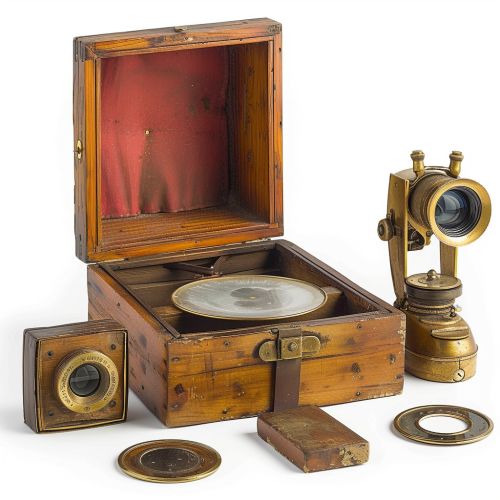History of Photography
Origins of Photography
Photography, as we know it today, has its roots in the scientific discoveries of the early 19th century. The first practical process of photography was introduced by Louis Jacques Mandé Daguerre in 1839. However, the concept of capturing an image had been toyed with long before Daguerre's discovery.


The camera obscura, a device that projects an image of its surroundings on a screen, was first used by artists and was a principle that was known in the times of Aristotle and Euclid. The camera obscura was essentially a large, closed box with a hole on one side of it. Light would pass through this hole, and since it travels in a straight line, the light would project an image of whatever was outside the box onto the opposite side of the box's interior.
Early Photographic Processes
The first successful photograph was made in 1827 by Joseph Nicéphore Niépce, using a sliding wooden box camera made by Charles and Vincent Chevalier in Paris. Niépce had been experimenting with ways to fix the images of a camera obscura since 1816. The photograph Niépce produced, a 20-minute exposure, has been lost to history, but it paved the way for future developments in photography.
In 1833, Niépce died, and his notes passed on to his associate, Louis Daguerre. Daguerre continued to experiment and evolve the process, eventually culminating in the development of the daguerreotype process, which was the most commonly used process until the late 1850s.


The daguerreotype process required only minutes of exposure in the camera, and produced clear, finely detailed results. It was commercially introduced in 1839, a date generally accepted as the birth year of practical photography.
Evolution of Photographic Technology
The development of photography was quite rapid, with significant advancements made in a relatively short period. The invention of the collodion process in the 1850s nearly replaced the daguerreotype, and provided a means of making multiple copies of a single image.
The dry plate process, introduced in the 1870s, allowed photographers to prepare their plates in advance and use them at a later date, a significant improvement over the wet plate collodion process, which required the plate to be coated, exposed, and developed within the span of about fifteen minutes.
The invention of gelatin silver process in the 1880s marked another major step forward in the evolution of photography. This process, which involved the use of gelatin instead of glass for the light-sensitive surface, made it possible to create highly detailed, long-lasting photographic prints.
The Birth of Modern Photography
The introduction of the Kodak camera in 1888 marked the beginning of amateur photography. This simple box camera came with a pre-loaded roll of film for 100 exposures and needed to be sent back to the factory for processing and reloading when the roll was finished.


The development of color photography was another significant advancement. Although experiments with color could not produce good results until the discovery of dye sensitization by Hermann Vogel in 1873, it was not until the 1940s that color film became widely available to the public.
Digital Photography
The advent of digital photography has led to an explosion in photography, both as a creative art form and as a hobby. The first commercially available digital camera was the Kodak DCS 100, launched in 1991.
Digital photography has completely changed the way we interact with images. Not only can we take thousands of pictures, we can also manipulate them in ways that would have been impossible in the darkroom.
Conclusion
Photography has come a long way since its early days. From the camera obscura to the digital camera, each development has had a significant impact on how we capture and view the world around us. As technology continues to evolve, it will be interesting to see where photography goes next.
